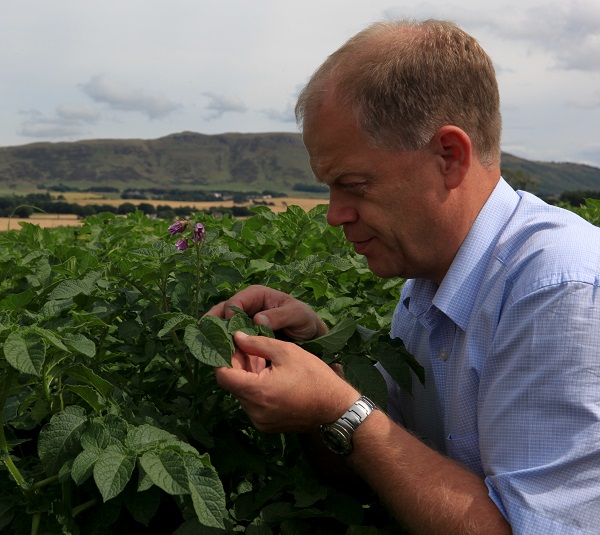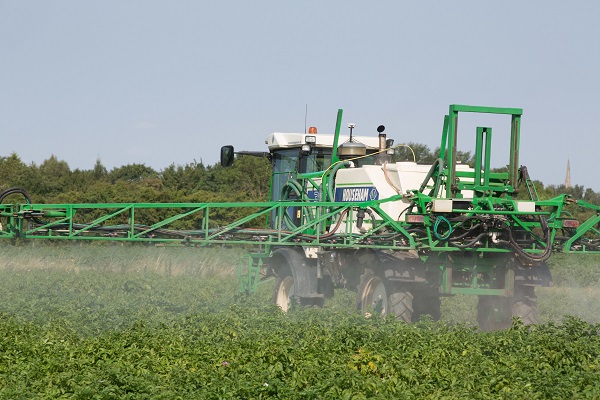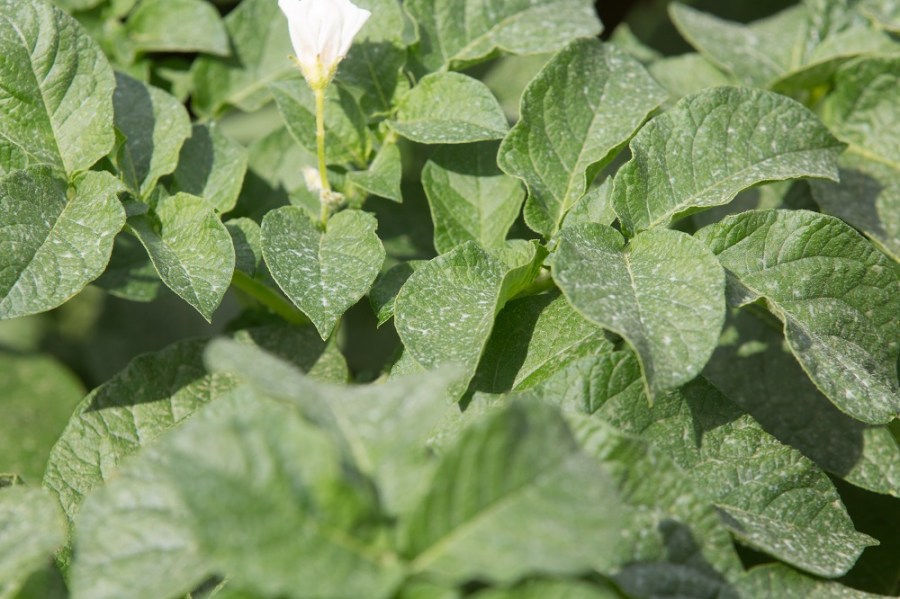The sprayer will soon be starting the weekly pilgrimage around potato fields in the effort to keep blight out of crops. CPM asks Eric Anderson for his thoughts on blight this season.
Failure to control blight within the canopy can be costly.
By Lucy de la Pasture
The mild weather that has signalled the start of spring will have stimulated the growth of groundkeepers and tubers in discard piles, raising the threat of blight in the early part of the season.
“Vigilance is central to protecting crops. Local sources of inoculum such as volunteers need to be minimised,” says Eric Anderson, Scottish Agronomy senior agronomist.
Perhaps importantly, the dominant clones – 6_A1 (Pink 6) and 13_A2 (Blue 13) – have remained largely unchanged since they were first detected in 2004 and 2005 respectively. This makes management simpler, says Eric Anderson.

Eric Anderson stresses that vigilance is key to protecting crops from blight.
“Growers understand what they are dealing with. Blue 13 is thought to have an advantage in colder temperatures, while Pink 6 is believed to produce more spores in warmer conditions. But in practice, it makes little difference to growers. Once temperatures pass 6oC and the air is moist, blight will sporulate.”
The detection of a new clone, 37_A2, in the Midlands is thought to be a result of infected seed and while it shouldn’t be downplayed, there’s currently no suggestion it will develop to challenge the dominant strains, he believes.
“Five cases in a relatively small geographical area suggests it’s somewhat aggressive, but we need another year before we can say more. We will learn more this season should it be detected again,” he adds.
In an isolated incident, 33_A2 (Green 33) was detected after a three-year absence. Eric Anderson was the agronomist who isolated the sample for analysis in 2013 in a neighbouring parish, so a local source of inoculum is the most likely source of infection.
“This strain is known to have reduced sensitivity to fluazinam and its detection highlights the importance of rotating products with different modes of action,” he says.
Messages about product stewardship are often well heeded, but he says it’s disappointing that advice about the need to protect against tuber blight infection is often less widely adopted.
“The breakdown of some processing crops in store over the winter suggests while most growers are adept at keeping on top of foliar blight, some have failed to tackle stem and haulm blight as well as they might. This often comes with a sting in the tail at the end of the season,” he adds.

Once crops reach tuber initiation, it’s time to utilise the better anti-sporulant products.
“Failure to control blight within the canopy can be costly. Sporangia and zoospores are easily washed down from leaves and infected stems to infect tubers. Sporangia washed down to the soil can remain viable for up to three weeks, with the inevitable consequences at harvest and in storage,” he says.
Aside from prompting growers to be better prepared this year, he’s advising they make more strategic use of those products with recognised anti-sporulant activity in a bid to protect tubers.
“The basic message this season is the same as always, ‘start early’. But once crops reach tuber initiation, it’s time to utilise the better anti-sporulant products, such as Infinito (propamocarb+ fluopicolide) or Invader (dimethomorph+ mancozeb).
“Where anti-sporulant activity is required to tackle active blight, then cymoxanil plus propamocarb (as in Proxanil) can be added to Ranman Top (cyazofamid) or Revus (mandipropamid), but there’s no need to tank-mix with Infinito as its performance is not in question,” he says.
Industry view on Hutton Criteria
The recently defined Hutton Criteria will replace the established Smith Period which has served as a measure of blight activity for the past 60 years. The emergence of more aggressive strains capable of sporulating at lower temperatures than those defined by Smith has supported the need for revised criteria to better reflect the blight pressure during the season.
“The Hutton Criteria gives us a more accurate tool to indicate high-risk periods of disease development and is an improvement on the Smith Period, but it should be remembered that these are a reactive measure and not necessarily an indicator of future pressure,” says Edward Hagues, Bayer root crop product manager.
“Having a more accurate tool to indicate periods of high blight pressure will give valuable information, although the overall blight strategy will change little. As with the Smith Period, Hutton Criteria informs us of risk after the event, albeit more accurately.
“A robust, preventative programme will still be necessary to protect crops. It’s important not to give blight a window of reduced protection in the programme where infection could take hold,” he says.
Eric Anderson welcomes the introduction of improved criteria, but warns that if it’s to be properly utilised, growers will need in-field weather stations rather than relying on reports from synoptic stations, often based on RAF bases near the coast.
“The Hutton Criteria is a useful addition to the risk models, but it can only be exploited fully if there are weather stations in-field. Our experience suggests that relying on data obtained several metres above the ground under-reported the number of Smith Periods as detected in-field by a factor of two,” he concludes.
Read our other blight control article – Fertiliser with benifits




